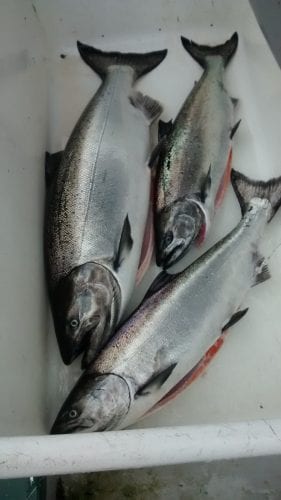Commercial salmon trollers in Southeast Alaska have their first king opening of the summer season Saturday, July 1st. For the summer season, the fleet has an allocation of 90,000 Chinook managed under the Pacific Salmon Treaty between the U.S. and Canada. The Alaska Department of Fish and Game is seeking to target 70 percent of that, or 63,000 treaty kings in the first of two possible openings.
Grant Hagerman is the Alaska Department of Fish and Game’s troll management biologist for Southeast. He said the department will be monitoring the catch and expects the opening to run six or seven days. “Really the first couple days is a large indicator of the abundance of fish,” Hagerman said. “There’s typically a build up of fish that happen. You know those first couple days, those fish are there and catch rates just tend to drop, there’s what we call kindof a fish down effect. So we’re just hoping that the fleet stays in contact with us, we get some landing information and just find out how steep that fish down effect is and if we are seeing truly a reduced abundance of fish by day 2, day 3 as those fish get caught up.”
Because of low king salmon abundance, the overall troll allocation for combined winter, spring and summer seasons is more than 100,000 fish lower than last year. The target number for this year’s first troll opening is roughly half of the target from last July.
The catch from the winter season this year was 42,500 treaty Chinook while the catch from the spring season is expected to be 17,300 once the season finishes at the end of this month. The spring season was shut down for several weeks because of low returns to Southeast Alaska rivers.
Trollers catch a mix of hatchery and wild stock kings that originate in Alaska, British Columbia and the Pacific Northwest states. The allocation numbers for treaty kings do not include fish that come from Alaska hatcheries. The troll fleet will get more of a chance to keep those hatchery Chinook later in the summer, sometime after the first opening. It’s called a mark-select fishery where Fish and Game will permit trollers to keep kings that are missing their adipose fin, a mark of a hatchery fish.
“So the mark-select fishery, basically it’s designed to allow them to harvest those surplus hatchery fish that are adipose clipped at a time when they normally would be shaking those fish and just targeting cohos,” Hagerman explained. “So this is just an opportunity to take advantage of those fish that are around.”
Hagerman said that fishery will be open sometime in between the first king opening and a second one in August. That’s a time when the fleet is normally pursuing coho or chum salmon. The mark-select fishery was tried later in the season last year.
Something else new this year, the waters in northern Lynn Canal are closed to commercial trolling for the entire summer season. That’s to protect kings returning to the Chilkat River near Haines.










